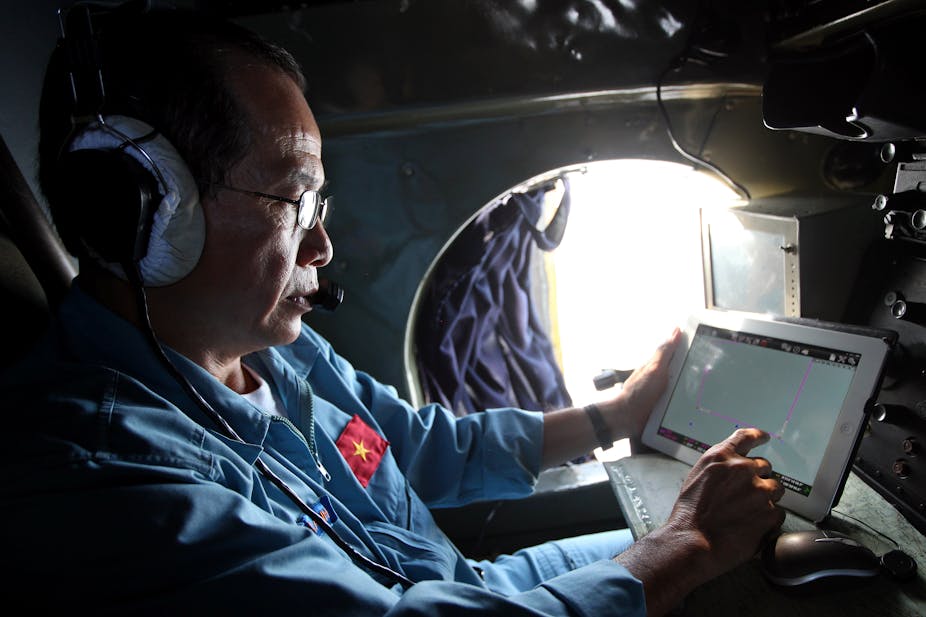As the biggest ever hunt for a missing plane continues, many are beginning to wonder if we will ever know what happened to Malaysia Airlines flight MH370. If the plane has crashed, it has been suggested that it could take up to two years to find its wreckage.
But if MH370 had been fitted with technology that made use of the cloud it may never have been lost in the first place. The cloud is a cluster of computers that provides reliable computing and storage as a service to large numbers of requests from computers with limited capabilities, such as those on board a plane or inside a mobile phone.
Instead of relying on the combination of GPS, primary and secondary radar, and aircraft communications addressing and reporting systems (ACARS) to keep track of planes, we should be making sure they send regular flight information to the data centres in the cloud. Planes would then send information such as aviation signals and pilot conversations as a compressed digital stream efficiently through satellite networks.
We still don’t know if MH370 disappeared because of a technical failure or a malicious security breach. It has been mooted that the pilot or a member of in-flight staff turned off the communication channels and used unusual flying manoeuvres to avoid being detected by the primary radars on ground and the secondary radars on board nearby planes. There are ways of responding to this scenario too.
Although transmission responders (also known as transponders) can send a unique four-digit code to identify the plane as a way to help aeroplanes maintain a safe distance from each other when in flight, these can be turned off by pilots. If we are now in a world in which we have to question the intentions of pilots, there are more security implications to consider.
A conceivable solution to this problem is to run from the ground a simulation of a plane’s flight while it is in the air and to selectively compare the meaningful changes of information with those intermittently sent from the pilot and on board systems. This would enable people on the ground to verify information such as altitude and course in real time and to double check that all is well. In normal circumstances this system would minimise risks and increase safety of the plane and its passengers. In case of foul play on board, the system would be able to spot that the information sent from the plane was incorrect.
When is a plane like bitcoin?
Spotting misinformation would be possible if we made better use of the cloud too. Using verifiable algorithms at scale we could tell encrypted communication data on the plane is not altered by checking its mathematical hash function, which is the application of a mathematical algorithmic calculation to a set of data that will give a unique result. Any subsequent changes to the data will change the “hash value” of the data set. Hashing is used to evidence a fact that data has not been altered.
This type of check is already used in bitcoin verifications. Computing a large number of hash values and verifying their authenticity against fakes requires a substantial amount of computation power, so cloud computing, multi-core graphics processing units and application-specific integrated circuits, which are specially designed to do just one job and do it well, are used to enable multiple tasks to be carried out at the same time.
A specifically designed protocol such as bitcoin relies on thousands of volunteers to use their own computers to verify computations for a small monetary return. While doing something similar to verify air traffic data would not be done for money, we might be able to call on people to give up computing power as a way of improving general flight safety for passengers since many of us fly at some point in our lives.
After switching to the cloud, traffic controllers would be able to notice abnormalities even if the pilots refused to cooperate and switched off its communication with the ground. They would be in a much better position than they are in the case of MH370. Cheating the ground or vice versa is substantially harder because parts of the data collected from the plane are produced automatically as it moves so no one can hack into it.
The groundwork for this system of proactive verification is being laid already as part of an ongoing research programme. The mystery surrounding flight MH370 should galvanise authorities to help find the resources and enough good will to have it fully developed and implemented.

